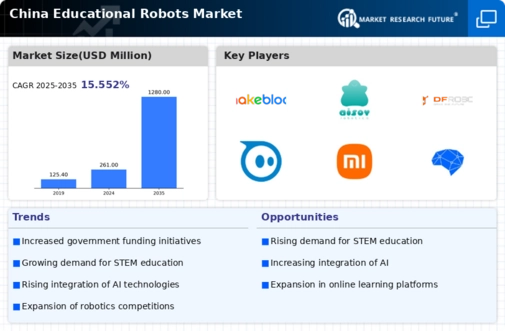Advancements in Robotics Technology
Technological advancements play a pivotal role in shaping the educational robots market in China. Innovations in artificial intelligence, machine learning, and robotics are driving the development of more sophisticated educational robots. These advancements enable robots to perform complex tasks, such as real-time feedback and interactive learning experiences. The market is projected to grow at a CAGR of 15% over the next five years, reflecting the increasing adoption of these technologies in educational settings. As educational institutions seek to enhance their curricula, the demand for advanced educational robots is expected to rise significantly.
Rising Demand for Personalized Learning
there is a notable surge in demand for personalized learning solutions in China.. As educational institutions increasingly recognize the importance of catering to individual learning styles, the integration of robots into classrooms appears to facilitate tailored educational experiences. This trend is supported by a report indicating that approximately 70% of educators believe personalized learning enhances student engagement. Consequently, the educational robots market is likely to expand as schools and universities invest in robotic technologies that adapt to diverse learning needs, thereby fostering a more inclusive educational environment.
Growing Emphasis on Interactive Learning
is significantly influenced by the growing emphasis on interactive learning methodologies.. Educators are increasingly adopting hands-on, experiential learning approaches that engage students more effectively. Educational robots serve as tools that facilitate interactive learning experiences, allowing students to experiment and explore concepts in a dynamic manner. This shift towards interactive learning is reflected in a survey where 80% of teachers reported improved student participation when using educational robots. As a result, the educational robots market is likely to benefit from this trend, as schools seek innovative ways to enhance student engagement.
Increased Investment in Robotics Education
Investment in robotics education is a critical driver for the educational robots market in China. With the government and private sectors recognizing the importance of equipping students with essential skills for the future, funding for robotics programs is on the rise. Reports indicate that funding for STEM education initiatives has increased by 25% in recent years, leading to a greater emphasis on integrating robotics into the curriculum. This influx of investment not only supports the development of educational robots but also encourages collaboration between educational institutions and technology companies, further propelling market growth.
Expansion of Robotics Competitions and Events
The expansion of robotics competitions and events in China serves as a vital driver for the educational robots market. These competitions not only promote interest in robotics among students but also provide practical applications for the skills learned in the classroom. With an increasing number of regional and national competitions, participation rates have surged, encouraging schools to invest in educational robots to prepare their students. The educational robots market is expected to see growth as more institutions recognize the value of these competitions in fostering creativity and problem-solving skills among students.
















Leave a Comment